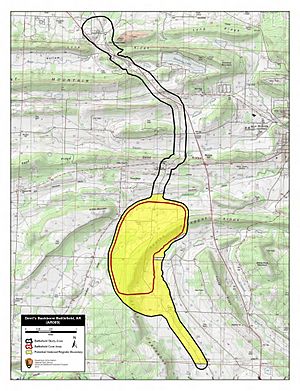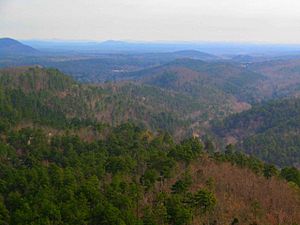Battle of Devil's Backbone facts for kids
The Battle of Devil's Backbone was an important fight during the American Civil War. It happened in a place called Devil's Backbone, which is a ridge in the Ouachita Mountains in Arkansas. This battle was part of the fighting that took place west of the Mississippi River. It happened on September 1, 1863, in Sebastian County, Arkansas. The Union side won, which helped keep Fort Smith safe for the rest of the war.
Quick facts for kids Battle of Devil's Backbone |
|||||||
|---|---|---|---|---|---|---|---|
| Part of the Trans-Mississippi Theater of the American Civil War |
|||||||
 Devil's Backbone Battlefield |
|||||||
|
|||||||
| Belligerents | |||||||
| Commanders and leaders | |||||||
| Units involved | |||||||
| 2nd Kansas Cavalry 6th Missouri Cavalry 2nd Indiana Battery |
1st Arkansas Cavalry 6th Arkansas Cavalry |
||||||
| Strength | |||||||
| 1,500 | 1,250 | ||||||
| Casualties and losses | |||||||
| 16 | 65 | ||||||
Contents
Why the Battle Happened
In August 1863, Union General James G. Blunt had pushed Confederate soldiers further south. He then quickly moved his troops towards Fort Smith. On August 31, Blunt's troops had a small fight with Confederate General William L. Cabell's soldiers near Fort Smith.
General Cabell decided to pull his troops back. He sent his wagons with supplies and weapons away that evening. The next morning, General Blunt found out the Confederates were leaving. He took some of his soldiers and captured Fort Smith easily. Meanwhile, Colonel William F. Cloud led about 1,500 Union cavalry (soldiers on horseback) and artillery (soldiers with cannons) to chase after Cabell.
Cabell's troops were heading towards Waldron, Arkansas. Cabell then decided to turn around. He wanted to slow down the Union soldiers so his wagons could get away safely. He had about 1,250 soldiers. However, not all of them were ready to fight. Some of Cabell's soldiers were not very interested in fighting for the Confederate side.
Cabell hid some of his best cavalry soldiers at the bottom of Devil's Backbone ridge. Other cavalry units, which were not as reliable, were placed on the hillside. An artillery battery (cannons) and an infantry regiment (foot soldiers) were positioned a bit further up the slope.
The Battle Begins
The fighting started around noon. Colonel Cloud's lead group of Union soldiers rode right into Cabell's hidden cavalry. The Union soldiers were surprised and had to fall back. Then, the Confederate cannons started firing at the rest of Cloud's arriving troops.
The Union soldiers quickly set up their own cannons across the road. Cloud's cavalry soldiers got off their horses and spread out on both sides of the road. They moved forward to the base of the ridge and started climbing the slope. The hidden Confederate cavalry soldiers retreated even before the Union troops started shooting.
At this point, Cabell's less reliable units showed their true colors. An officer from Cabell's infantry said that as the Union soldiers got close, the Confederate regiment in front ran away without firing a shot. They ran through the two regiments behind them, causing those soldiers to run away too. This chaos swept away part of Cabell's infantry. Suddenly, Cabell's force was much smaller. He was left with only one cavalry regiment, the cannons, and a part of his infantry.
Fighting on the Ridge
Colonel Cloud pushed his dismounted cavalry soldiers closer to the Confederate line at the top of the ridge. The fight turned into a long exchange of small-arms fire and cannon shots. This lasted for about three hours. Cabell personally directed the fire of his cannons. Cloud's men sometimes pretended to attack, but they never actually charged. Both sides seemed happy to just keep shooting at each other without getting into close combat.
After the Battle
When the fighting stopped, both sides claimed they had won. Colonel Cloud reported that the Confederates suddenly left when the Union stopped firing for a moment. Cabell might have misunderstood this pause. He reported that Cloud's troops were pushed back and then the Confederates left.
However, the Union forces were left in control of the battlefield. All contact with Cabell's troops ended when he pulled away. Cabell reached Waldron the next day, and Cloud returned to Fort Smith.
By capturing Fort Smith and winning at Devil's Backbone, the Union forces gained an important position in the Arkansas River Valley. From this spot, Union soldiers could fight Confederate groups. They also marched to join the Camden Expedition in April 1864. This victory helped the Union efforts in Indian Territory. Even though the later Battle of Massard Prairie in July 1864 showed that Fort Smith could still be attacked, it remained a Union base for the rest of the war.
Saving the Battlefield
The Civil War Trust, which is now part of the American Battlefield Trust, has helped save 10 acres of the Devil's Backbone Battlefield. This helps protect the land where this important battle happened.


